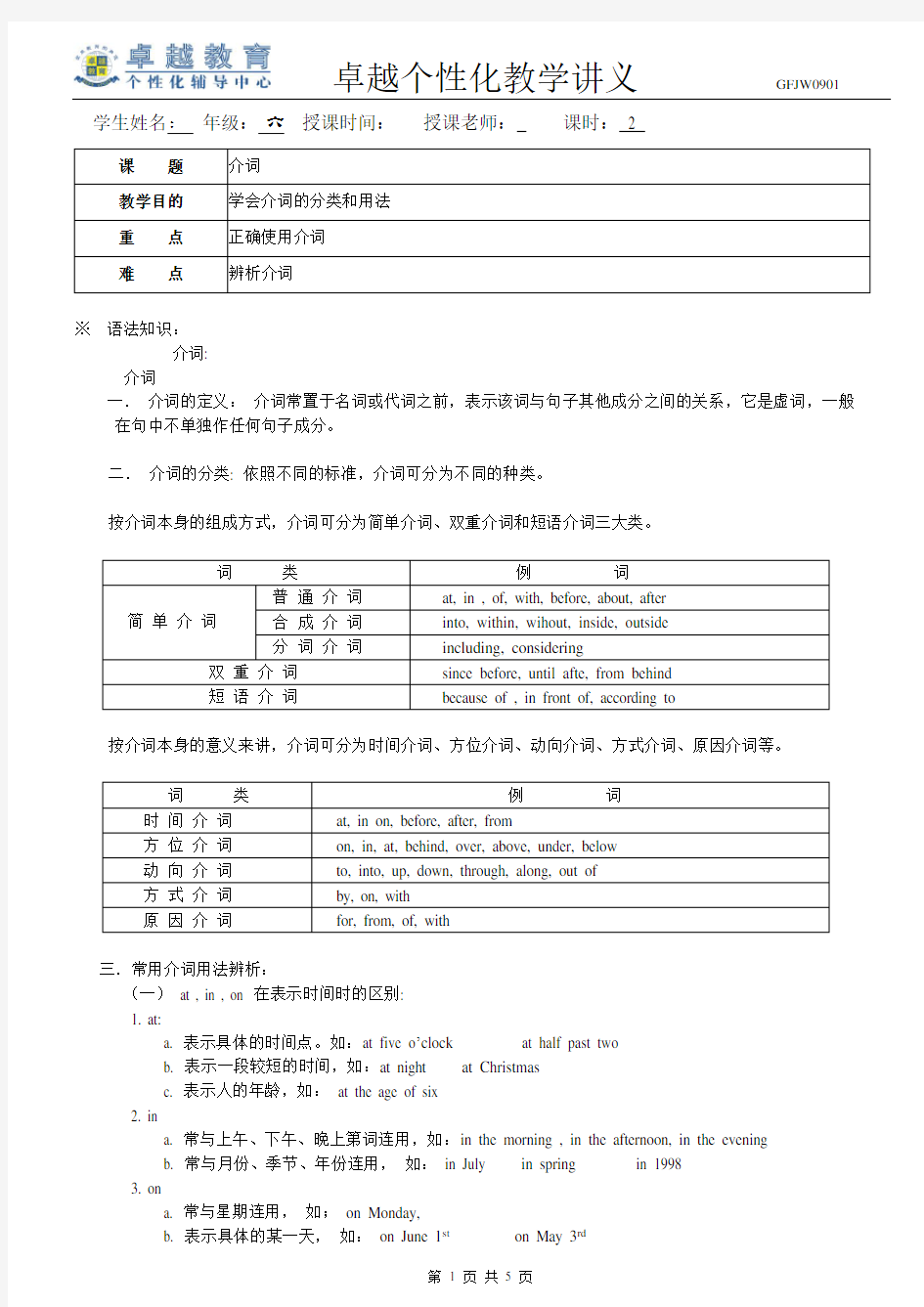介词的分类与用法

- 1、下载文档前请自行甄别文档内容的完整性,平台不提供额外的编辑、内容补充、找答案等附加服务。
- 2、"仅部分预览"的文档,不可在线预览部分如存在完整性等问题,可反馈申请退款(可完整预览的文档不适用该条件!)。
- 3、如文档侵犯您的权益,请联系客服反馈,我们会尽快为您处理(人工客服工作时间:9:00-18:30)。
卓越个性化教学讲义GFJW0901学生姓名:年级:六授课时间:授课老师:课时: 2
课题介词
教学目的学会介词的分类和用法
重点正确使用介词
难点辨析介词
※语法知识:
介词:
介词
一.介词的定义:介词常置于名词或代词之前,表示该词与句子其他成分之间的关系,它是虚词,一般在句中不单独作任何句子成分。
二.介词的分类: 依照不同的标准,介词可分为不同的种类。
按介词本身的组成方式,介词可分为简单介词、双重介词和短语介词三大类。
词类例词
简单介词普通介词at, in , of, with, before, about, after 合成介词into, within, wihout, inside, outside 分词介词including, considering
双重介词since before, until afte, from behind
短语介词because of , in front of, according to
按介词本身的意义来讲,介词可分为时间介词、方位介词、动向介词、方式介词、原因介词等。
词类例词
时间介词at, in on, before, after, from
方位介词on, in, at, behind, over, above, under, below
动向介词to, into, up, down, through, along, out of
方式介词by, on, with
原因介词for, from, of, with
三.常用介词用法辨析:
(一)at , in , on 在表示时间时的区别:
1. at:
a. 表示具体的时间点。如:at five o’clock at half past two
b. 表示一段较短的时间,如:at night at Christmas
c. 表示人的年龄,如:at the age of six
2. in
a. 常与上午、下午、晚上第词连用,如:in the morning , in the afternoon, in the evening
b. 常与月份、季节、年份连用,如:in July in spring in 1998
3. on
a. 常与星期连用,如;on Monday,
b. 表示具体的某一天,如:on June 1st on May 3rd
c. 表示某天的上午、下午或晚上,如:on Friday morning on a winter evening,
on the afternnon of May
(二) in ,after 在表示时间时的区别:
1. in+ 某个时间词组表示从现在起多长时间,多用于将来时,说明将会发生某事。
He will return in three days.
2. after+ 某个时间词组表示从过去某个时间起过多长时间,多用于过去时。
He left on Sunday and returned after three days.
(三)by 和before 在表示时间时的区别:
1. by 表示到某一时间为止。
He promised to be here by seven o’clock.
2. before: 表示在某一时间之前。
They left before seven.
(四) in和at在表示地点时的区别:
1. in:表示在某物里面,也可表示在一个很大的空间内,in 后可接较大的地点和场所。
They are some pens in the box.
He lives in Beijing.
2. at: 表示在某物旁边、周围,不强调某物的空间。at后可接小的地点和场所。
Who’s standing there at the door?
They arrived at the station early in the morning.
(五) in, to, on 在位置上的区别:
1. in 表示某物在某一区域范围内。
China is a country in Asia.
2. on表示事物与另一区域范围属于相邻接的关系。
We live in a house on the Thames.
3. to表示某物在某一区域范围之外的某一位置。
The town lies to the south of the villages.
(六)across, through在表示位置上的区别:
1. across 指“穿过”这一动作在某个物体的表面进行。
He walked across the road carefully.
2. through指“穿过”这一动作在某个物体的空间进行。
He walked through the forest alone.
(七) above, over, below, under在位置上的区别
1. above表示两个物体一个的上方,但不一定是在正上方,而且两个物体之间没有接触。
The bird are flying above the trees.
2. over表示垂直在上的正上方,两个物体表面没有接触。
A picture of Lu Xun was hung on the wall over the desk.
3. below意为“在…的下面,不一定是在正下方。
The climbers stopped 300 meters below the top of the mountain.
4. under表示一物在另一物垂直的正下方。
I found my key under the table.
(八) among , between的区别:
1. among用于三者或三者以上的“在…中间。
He is standing between the t wo buildings.
四.常见介词短语:
1. 动词+介词
agree with 同意ask for 索要belong to 属于listen to 听
look for 寻找turn on/off 打开/关闭take care of 照顾、照料
wait for 等待talk about/of 谈及leave for 动身前往look at 看
